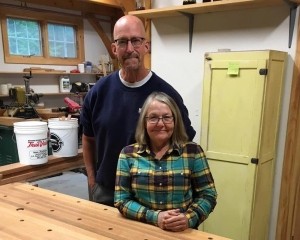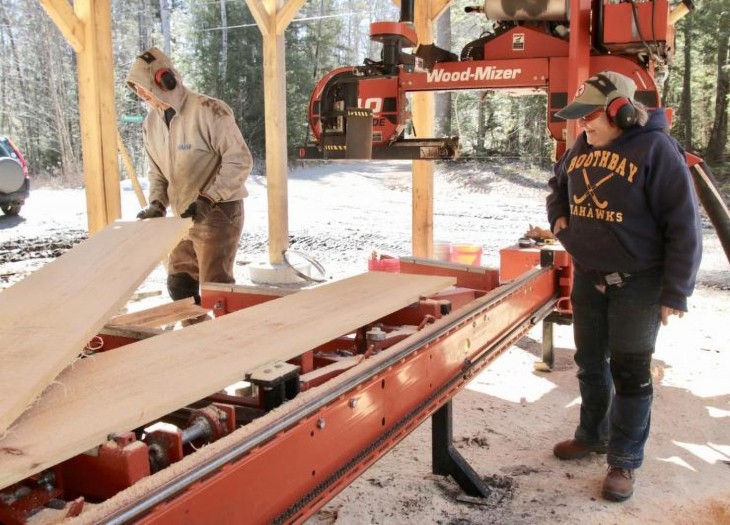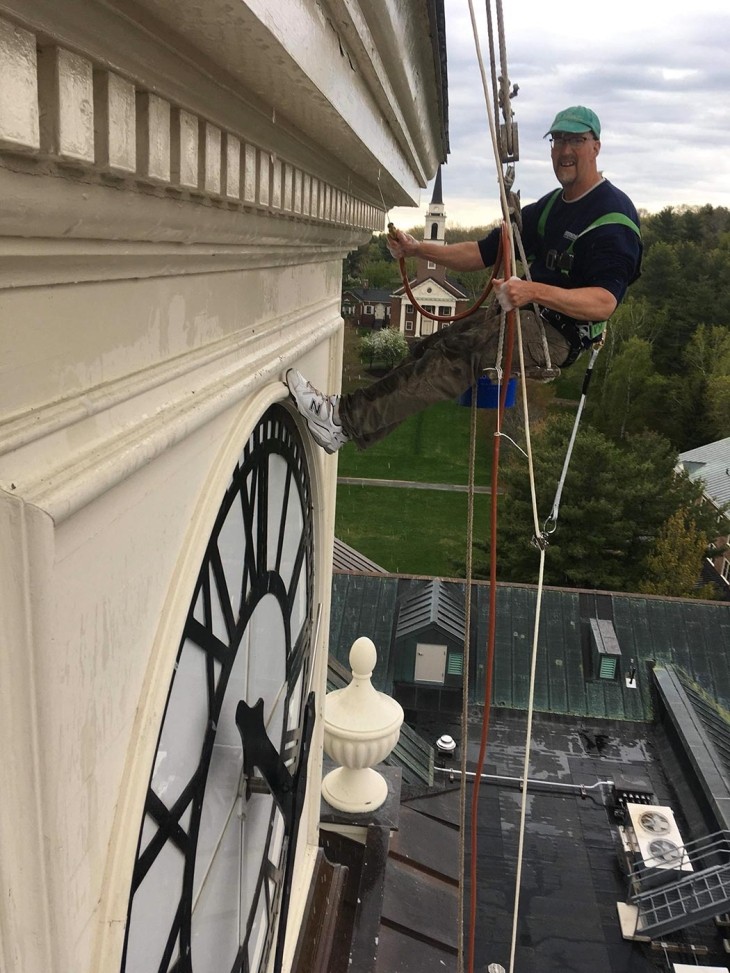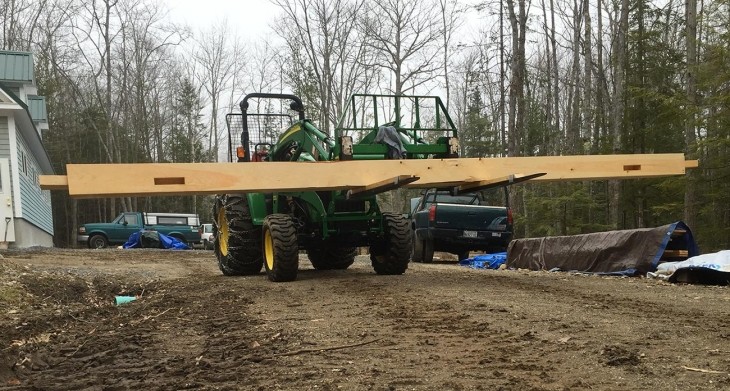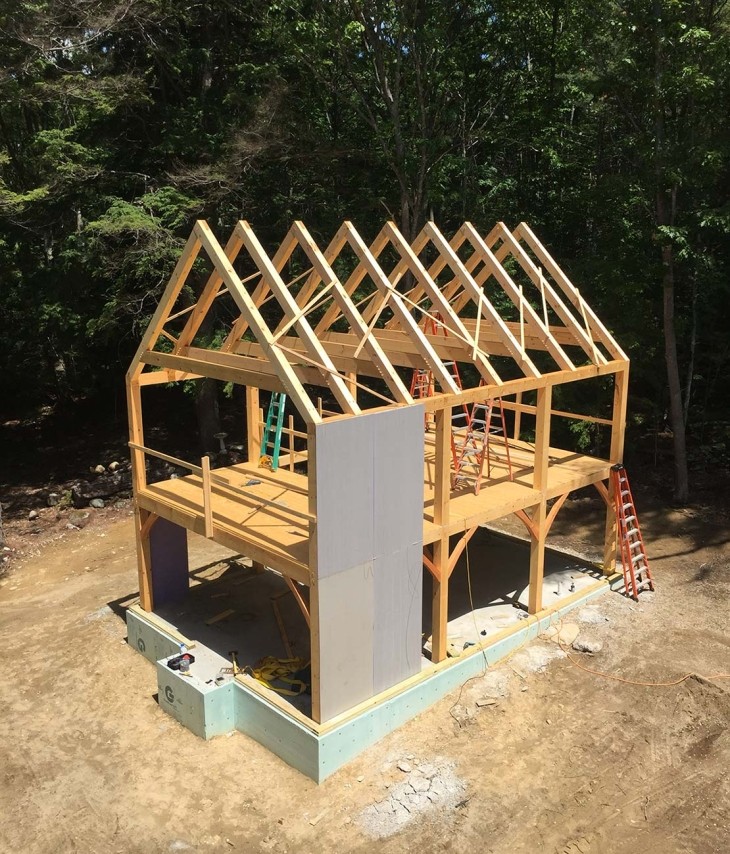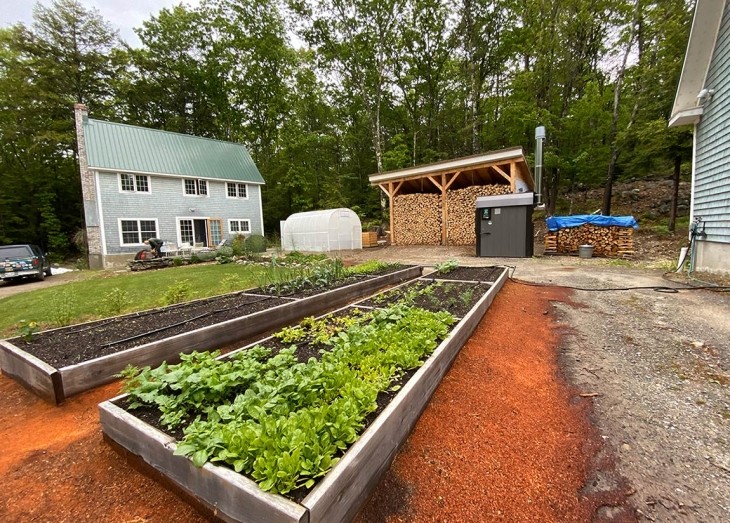Joe and Lisa McSwain are of an age when they might think of retiring, but a life of leisure doesn’t appeal to them. A few years ago, they sold the steeplejack company they’d run for about 35 years, Mid-Maine Restoration, and started a new endeavor, Mid-Maine Millwork. With their six children now grown, the Edgecomb, Maine, couple also sold the rambling farmhouse where they raised their family and downsized to a timber-frame home they built themselves – along with a shop, woodshed, and other outbuildings – adjacent to the town-owned Schmid Preserve, which they help to steward.
Tell us how you landed in Mid-Coast Maine.
Lisa: I grew up in northern New Jersey, right by New York City, in suburbia. I did spend a lot of time in the outdoors, mostly by the saltwater, a lot of time on boats – sailing and swimming and fishing. I went to Bennington College in Vermont and majored in sculpture, so I learned how to weld, and I learned how to use tools. One summer during college, I was a volunteer at The Apprenticeshop in Bath, Maine, which was a boat-building school attached to what is now the Maine Maritime Museum. When I finished college, The Apprenticshop had an opening for an apprentice. I applied for it, and I was accepted. I moved to Maine in 1976, and I never left. I moved into a yurt community with no running water or electricity. I worked in the boat building shop all day. That was my introduction to Maine, and I just loved everything about it. That was also my introduction to woodworking.
Joe: I grew up in Foxborough, Massachusetts, when there were still open spaces. I spent almost all my time outdoors, hunting, fishing, hiking, getting into trouble. I went to college at the University of Connecticut and grad school at Brown University in Providence, Rhode Island. I started out studying chemical engineering in college but ended up as an English major and decided I’d be a teacher, so I got a master’s degree in education. I did teach for a while. I was a high school principal for a time. I just didn’t really like to be inside. I’d rather work with my hands. I did quite a bit of hiking as a kid and went to Baxter State Park when I was 13 or 14, and I just thought it was the coolest thing ever. I spent the next 10 years trying to get back there, and I finally did. I arrived around 1981.
How did you end up starting a steeplejack business?
Joe: My cousin had worked high steel – working on the steel frames of high rise buildings and bridges – and I did a little bit of that. The company that he worked for would send a crew every so often to paint a church steeple. It didn’t seem like there were enough people doing that type of work, and he thought we ought to try it, so we did. We worked together for a few years, then we each ran our own companies. I worked as a steeplejack for about 40 years.
Lisa: Our small company worked on church steeples and towers all over New England, mostly in Maine and New Hampshire. It was a really hard job, but it was pretty interesting. Of course, I got sucked right in. I found that I had these skills with woodworking and painting from my boatbuilding work, and I just kept doing it. I really liked it, although it was a little terrifying at times to be hanging off a steeple.
What was the best part of working as a steeplejack?
Joe: We would go wherever the work took us, and it took us to places that I don’t think I would ever have seen if folks hadn’t called about a steeple or a stack or a clock tower. You got to see famous places in cities. You got to view the place from a perspective that most people never saw.
Lisa: It was just really cool to see the construction and the craftmanship that went into these churches. Some tiny, tiny hamlets that were in the middle of nowhere had these amazing, beautiful steeples or towers. I was always amazed by how much time and effort went into building these and how much was done by hand – and trying to recreate that and not destroy the historic part of it.
Are you still involved in the company at all?
Lisa: We sold Mid-Maine Restoration to our lead foreman, Andrew Wilcox, a few years ago. He worked for us for so long, he really feels like one of our kids. It was a win-win for all of us. We still work for him. Joe does all the millwork for him. There’s a lot of really specialized millwork attached to these steeples and towers. They’re all old, and there’s a lot of historic stuff involved, and Joe is very clever and can recreate all the molding, unique top ornaments, balustrades. He is an amazing woodworker. And I still keep the books for Andrew.
So, you sold the business, but retirement wasn’t on the table?
Joe: I sort of like to get up in the morning and have something to do, some kind of a purpose. Once we sold the business, we bought a Wood-Mizer LT-40 Wide mill. It is hard work, but it’s fun. I’ve been sort of relegated to the heavy lifting side of the operation. I was the one who learned to run the mill, three or four years ago, but one day I wandered away to take a phone call, and when I came back, Lisa was running the mill. So now she runs the mill, and I move the logs and the lumber around.
Lisa: I love doing it. It’s good that we both know as much as we do about it, because there’s a lot of things that can go wrong at any time. It’s good to have two people kind of watching what’s happening, because there’s a lot of adjusting, and there’s a lot of math. It’s worked out pretty well.
What sorts of work do you do with the mill and the woodshop?
Joe: We do some onsite milling for people, but mostly we keep the mill here. We sell lumber, mostly softwood. I also make some furniture for sale, although I’m kept about as busy as I want to be making stuff for the kids and friends. During my steeplejack years, I learned how to do a lot of strange millwork associated with old church steeples and clock towers, so I know that pretty well. A lot of times, other woodworkers will look at a balustrade that’s got a hundred turned balusters and say, “I’m not doing that.” I know how to do it, I’ve done it, we’re set up for that sort of thing, so we’ll take that stuff on.
Lisa: We just built the bell wheel for a historic meeting house. It was a lot of work, and it turned out beautifully. Those are the kinds of jobs he gets in the shop – really strange things made out of wood that people want to recreate. Most of what we saw is softwood. We do saw quite a bit of red oak, because there’s a lot of that around here.
Where do you source your wood?
Lisa: Most of our sourcing is from local arborists. Sometimes we have to buy wood from a specialty wood dealer. For the bell wheel, for example, it had to be out of white oak, and it had to be kiln dried. But we don’t have any trouble getting pine and spruce and fir and hemlock. There’s a lot of hemlock, because the hemlock woolly adelgid kills it off. We just took down two giant hemlocks right behind our house because of the adelgid.
Joe: Unfortunately, there’s going to be a lot of stuff like that. There’s going to be a glut of hemlocks, and ash with the emerald ash borer. I don’t know what the forest is going to look like 50 years from now, but it’s not going to look the way it does today.
You built your own house, is that right?
Joe: Well, we built the shop first, and we lived above that while we were building the house. We used the shop to build the frame. We built it all ourselves. Lisa and I cut the frame for the house one winter.
Lisa: Where we live now is on 6 six acres, surrounded by a 766-acre nature preserve on three sides. We were thinking of selling the land, but instead we decided to sell our old farmhouse and our giant barn, which was our woodworking shop. Shelter Institute, which is a timber frame company and a school, is close to where we live. Before we moved here, Joe really wanted to take their 2-week course on timber framing. So he took that course one winter, and in the class, they built a 24-by-24-foot frame. They sold us two frames, we put them together, and that’s what we made the shop out of. Then we cut the frame for the house ourselves. It took us three years to build a 1,200-square-foot house. It’s such a beautiful house. It’s perfectly sized. Joe made all the built-in shelves and almost all the furniture in the house. And then, whenever the Shelter Institute guys had a class – before Covid hit – they would bring the students here, because our shop is timber frame, our house is timber frame, we have a big woodshed that’s timber frame – so they bring everyone here and show them around.
It seems as if many of the aspects of your life and work are connected. True?
Lisa: Everything that we have for work – it’s very functional. We have an outside wood boiler that heats all our buildings, so we have to process that wood every year. We have solar panels on the roof of the shop. I grow a ton of vegetables. We have a greenhouse and a hoop house and all these raised beds. We could probably just go to the store and buy the food or heat the house with oil, but we choose not to do that. We’re trying to live as much off the grid as we can.
Joe: We heat the shop, the office, the house, a greenhouse, and domestic hot water in two buildings with the wood boiler. If we had heated with oil, it would have cost $10,000 this year. A lot of what goes into the wood boiler is throw-off from the sawmill, so that works out real well. If we’re not sawing, we’re splitting firewood or stacking firewood or making something for the steeple company. And if we’re not doing those things, we’re up north flyfishing.
Flyfishing?
Joe: I learned to flyfish when I was 10. That’s part of the reason I wanted to come to Maine. I taught Lisa, and we taught all the kids. I tie my own flies. I build my own rods. I haven’t figured out how to build a reel, yet.
Lisa: As soon as May hits, we go on short trips. We go up to Baxter State Park or up to the AMC lands in the 100-Mile Wilderness. We’ve been fishing there for a really long time, and it’s always nice to just go back and see it in all different weather and seasons. It’s all native brook trout and salmon. We hardly ever fish anywhere where the fish are stocked. We try to go off the beaten path. We also spend a lot of time in the Schmid Preserve, behind our house, mainly working on the trails there, which are open to the public. I’m the chairman of the advisory committee that manages it. It’s such an amazing property. It’s the largest contiguous tract of land in the Mid-Coast area. We just started an endowment for it, and we’re working on raising money for long term management of the land.
So, what’s the secret to working together so successfully?
Joe: The trick is knowing who’s in charge – and it’s not me! There’s also a lot of cross over. For instance, with the mill, we both can do a number of different things, so if somebody gets tired of one thing, we’ll switch. And we can do that without giving much up in the way of production.
Lisa: Our birthday is on the same day. I don’t know if that really has anything to do with it, but we’re just very like-minded. It’s not like we haven’t had our ups and downs, but we’ve always had a pretty good division of labor. Joe does one thing, and I do the other. And Joe is a very good teacher if it’s something that he loves and that he’s good at. He’s taught me a lot. He’s very patient. And he also has been very willing to let me do it. A lot of people – a lot of men, especially – would be like, “Nah, you can’t do that.” I’m the type of person who likes to take on challenges. I’ve always worked in fields where there have been a lot of men. I don’t know if it’s because I’m so short or because I have such a big mouth, but I always force my way in and think, “I can do that, too.”


